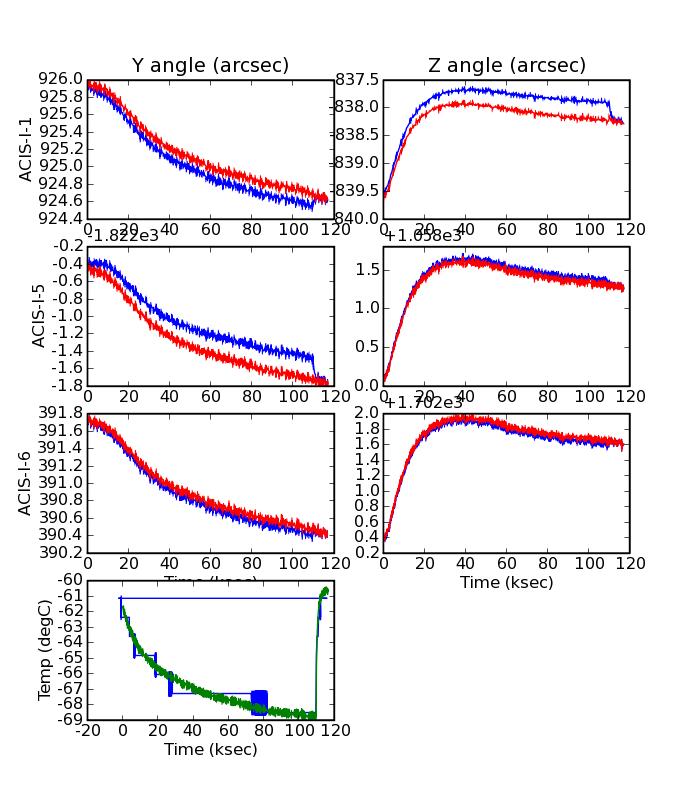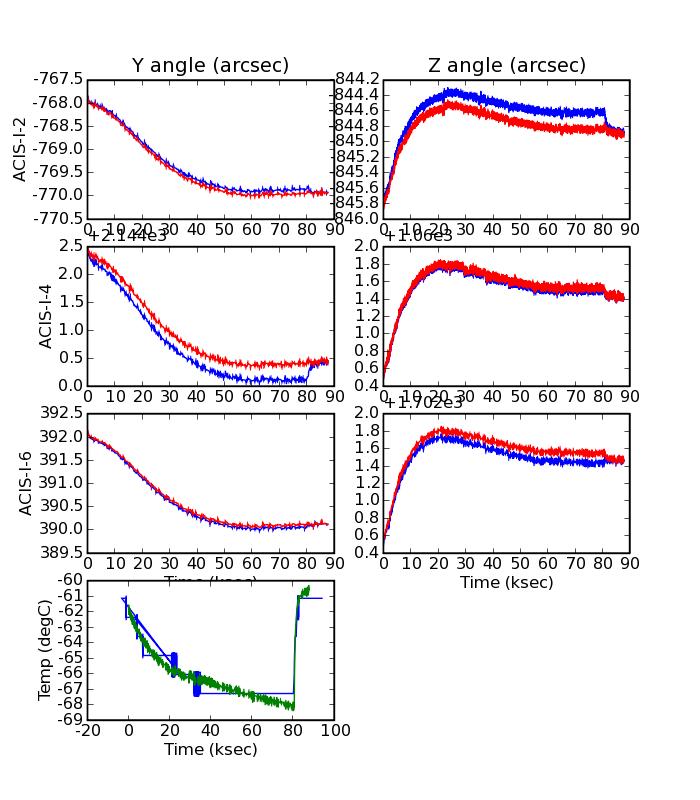Apply a correction to ACIS fid light centroid values to compensate for
variations in the ACIS detector housing temperature.
Description
In order to maintain control margin to keep the ACIS focal plane (FP) at the
nominal setpoint of -119.7 C, the ACIS detector housing (DH) heater will be
disabled. The ACIS fid lights are mounted on the ACIS DH. Allowing the DH
temperature to vary has the undesired side effect of producing noticable shifts
(up to 0.25 arcsec on time scales of hours) in the ACIS fid light positions due
to thermal contraction. For the first 8 years of the mission the DH was controlled
at a temperature of -60 C.
During the nine 2007 Chandra Deep Field South observations the DH heater was
disabled at the start and then re-enabled 2 hours before the end of each
observation. These tests were performed using a variety of fid light
combinations and the shift in fid light positions were fully analyzed. All
the data were well-described by a simple physical model of the fid light
positions contracting or expanding radially about a single center point with a
CTE that corresponds roughly to that of aluminum. The numerical fit values
coming out of that analysis are captured in the 'Fid and DH calibration constants'
listed below.
The center of expansion was determined in ACA angular coordinates for ACIS-I
observations with the nominal SIM-Z position. The most rigorous (and
physically accurate) way to represent these values would be to translate all
the derived angular values into physical coordinates (mm) on the ACIS focal
plane. Then this correction tool would use the full transformation chain from
ACIS focal plane to ACA coordinates to calculate the needed corrections.
However, given the small size of the correction and fairly large uncertainties
in the derived calibration parameters, we simplify processing considerably by
assuming linearity throughout the system and just using offsets with respect to
the fid light angular positions used in the CDF-S calibration test
observations. These are captured in the fid_[yz]_ang_nom arrays.
In order to compensate for the temperature-dependent shift in aspect pipeline
processing an estimate of the DH temperature is needed. This is available in
ACIS engineering telemetry as MSIDs 1CBAT and 1CBBT. Unfortunately the
digitization of these values is approximately 2.5 C and using them directly
would produce undesirable discontinuities in the aspect solution SIM DY, DZ and
DTHETA values. To avoid this we take advantage of the physical characteristic
of LEDs that they get brighter as the temperature is lowered. The test data
were used to calibrate a linear relationship between changes in DH temperature
and fid light brightness (counts).
Although the fid light brightness are fairly stable over the mission, we cannot
depend on stability to the level required for an absolute translation from fid
brightness to DH temperature. Instead a hybrid approach is taken -- read in
both the ACIS engineering temperature data and the fid data, filter to be using
only good quality values, and then match with a simple average over the aspect
time interval. At the same time apply the empirically determined scaling
factor to convert delta counts into delta degC. This results in a high-resolution
estimate of the actual DH temperature during the interval.
Using the DH temperature and the derived expansion coefficients, the expected
radial expansion or contraction is then removed from the observed (smoothed)
fid light centroids that are used in constructing the SIM displacement.
Correcting the centroids in place has the advantage that downstream tools (in
particular V&V) need no modification. The original (unmodified) centroid
values are still available in the unsmoothed angular centroids as well as the
original CCD pixel centroids.
|
|
|
|
|
|
|
|
get_acis0eng(files)
Read ACIS engineering telemetry opt.acisengfiles and return a pyfits
bintable HDU with time and detector housing temperature MSID columns. |
source code
|
|
|
|
|
|
|
calc_fid_center(acen,
fidprops,
opt)
Calculate fid light center of expansion by shifting the nominal fid center
based on the difference between the current observed fid positions and those
from the nominal (calibration) fid positions. |
source code
|
|
|
|
apply_cent_corr(times,
dh_temp,
acen,
fidprops,
opt)
Remove (subtract) the predicted amount of expansion based on the DH temperature
relative to the baseline temperature at which the fid positions were calibrated. |
source code
|
|
|
|
make_plot(plotfile,
times,
dh_temp,
acen,
fidprops,
acis0eng)
Make a plot of the before (using the unsmoothed centroids) and after centroids
for each fid light. |
source code
|
|


